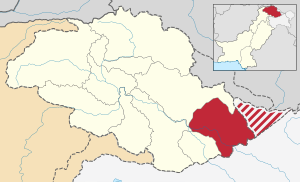
The Karakoram is a mountain range spanning the borders of China, India, and Pakistan, with the northwest extremity of the range extending to Afghanistan and Tajikistan; its highest 15 mountains are all based in Pakistan. It begins in the Wakhan Corridor (Afghanistan) in the west and encompasses the majority of Gilgit-Baltistan (Pakistan) and extends into Ladakh (India) and the disputed Aksai Chin region controlled by China. It is the second highest mountain range in the world and part of the complex of ranges including the Pamir Mountains, the Hindu Kush and the Himalayan Mountains. The Karakoram has eighteen summits over 7,500 m (24,600 ft) height, with four of them exceeding 8,000 m (26,000 ft): K2, the second highest peak in the world at 8,611 m (28,251 ft), Gasherbrum I, Broad Peak and Gasherbrum II.

Masherbrum is located in the Ghanche District, Gilgit Baltistan, Pakistan. At 7,821 metres (25,659 ft) it is the 22nd highest mountain in the world and the 9th highest in Pakistan. It was the first mapped peak in the Karakoram mountain range, hence the designation "K1".
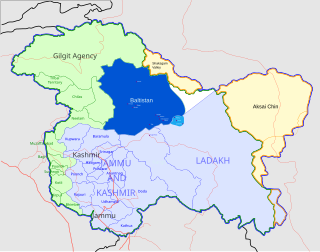
Baltistan, also known as Baltiyul or Little Tibet, is a mountainous region in Gilgit-Baltistan, Pakistan-administered Kashmir. It is located near the Karakoram mountains just south of K2, and borders Gilgit to the west, China's Xinjiang to the north, Ladakh to the southeast, and the Kashmir Valley to the southwest. Its average altitude is over 3,350 metres (10,990 ft).

The Karakoram Highway is a 1,300 km (810 mi) national highway which extends from Hasan Abdal in the Punjab province of Pakistan to the Khunjerab Pass in Gilgit-Baltistan, where it crosses into China and becomes China National Highway 314. The highway connects the Pakistani provinces of Punjab and Khyber Pakhtunkhwa plus Gilgit-Baltistan with China's Xinjiang Uyghur Autonomous Region. The highway is a popular tourist attraction and is one of the highest paved roads in the world, passing through the Karakoram mountain range, at 36°51′00″N75°25′40″E at maximum elevation of 4,714 m (15,466 ft) near Khunjerab Pass. Due to its high elevation and the difficult conditions in which it was constructed, it is often referred to as the Eighth Wonder of the World. The highway is also a part of the Asian Highway AH4.

Passu is a small village located in the Gilgit Baltistan region of northern Pakistan. Situated along the Karakoram Highway in Upper Hunza, Passu is a popular tourist destination because of its easily accessible sweeping landscapes, and vistas of the 7,478 m tall Passu Sar mountain, the Passu Glacier, and Tupopdan 6,106m.
Hispar Muztagh is a sub-range of the Karakoram mountain range. It is located in the Gojal region of Gilgit-Baltistan, Pakistan, north of Hispar Glacier, south of Shimshal Valley, and east of the Hunza Valley. It is the second highest sub-range of the Karakoram, the highest being the Baltoro Muztagh. The highest mountain in the range is Distaghil Sar (7,885m/25,869 ft).

The Baltoro Glacier, at 63 km (39 mi) in length, is one of the longest glaciers outside the polar regions. It is located in the Gilgit-Baltistan region of Pakistan. It runs through part of the Karakoram mountain range. The Baltoro Muztagh lies to the south and east of the glacier, while the Masherbrum Mountains lie to the south. At 8,611 m (28,251 ft), K2 is the highest mountain in the region, and three other Eight thousanders within 20 km. Siachen Glacier is separated from the Baltoro glacier by the Conway Saddle.

Batura Sar, also referred to as Batura I, is the 25th highest mountain on earth and the 10th highest in Pakistan. It is the highest peak of the Batura Muztagh, which is the westernmost subrange of the Karakoram range. It forms the apex of the Batura Wall, which is a continuously high part of the backbone of the Batura Muztagh.
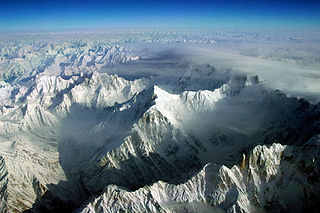
The Batura Muztagh mountains are a sub-range of the Karakoram mountain range. They are located in Gojal valley in the Hunza district of the Gilgit-Baltistan province in northern Pakistan.

Chilas is a city and is the divisional capital of Diamer District located in Gilgit-Baltistan, Pakistan, on the Indus River. It is part of the Silk Road connected by the Karakoram Highway and N-90 National Highway, which link it to Islamabad and Peshawar in the southwest, via Hazara and Malakand Divisions of Khyber Pakhtunkhwa. In the north, Chilas is connected to the Chinese cities of Tashkurgan and Kashgar in Xinjiang, via Gilgit, Aliabad, Sust, and the Khunjerab Pass.

The Masherbrum Mountains are a subrange of the Karakoram mountain range, in Ghanche District, Baltistan region of the Gilgit-Baltistan province in northern Pakistan.
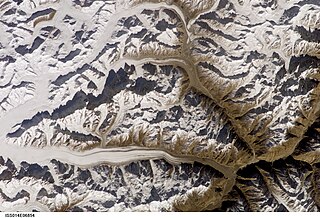
The Panmah Muztagh is a subrange of the Karakoram range, in Shigar, a district of Gilgit-Baltistan, Pakistan. Its highest peaks are not particularly high by Karakoram standards, but they are exceedingly steep rock spires, unlike many of the peaks in the surrounding subranges. In particular, the highest of the Panmah peaks, Baintha Brakk, is a very difficult climb; it has seen only two ascents. The nearby Latok group is of similar difficulty. Both groups lie on the north side of the long Biafo Glacier.

Babusar Pass or Babusar Top is a mountain pass in Pakistan at the north of the 150 km long Kaghan Valley, connecting it via the Thak Nala with Chilas on the Karakoram Highway (KKH). It is the highest point in the Babusar Valley that can be easily accessed by cars. The Babusar Pass connects Khyber Pakhtunkhwa with Gilgit Baltistan. It is one of the most dangerous routes in Gilgit-Baltistan. Every year many deaths happen here due to the mountainous slopes, which are among the most dangerous in the world. The most common reason for death is the brake failure of cars due to inexperience. Babusar Top was originally known as Babur Top, originating from the fact that the Mughal emperor Babur used to pass through this area in the early 16th century. Nowadays however, it is commonly referred to as Babusar Top.

Ghanche District is the easternmost district of Gilgit Baltistan, Pakistan. With its administrative headquarters in the historic city of Khaplu, Ghanche is famous as a tourist destination for its outstanding scenery and high altitude landscapes.
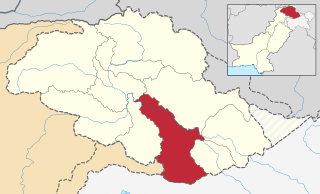
Skardu District is part of Baltistan and currently constitutes one of the ten districts of the Gilgit–Baltistan territory of Pakistan. It is bounded on the southeast by Kargil district in Ladakh, on the east by Kharmang District, on the northeast by Ghanche district, on the south by Baramulla and Kargil District, on the west by district Astore and on the north by Shigar District.

Gilgit District is one of the districts of the Gilgit–Baltistan territory in northern Pakistan. It was formed in 1970 when Gilgit–Baltistan was federally administered as the "Northern Areas". It is bounded by the Wakhan Corridor (Afghanistan) to the north; Xinjiang (China) to the northeast and east; Skardu, Astore and Diamer to the south; and Ghizer District to the west. The town of Gilgit is the capital of Gilgit District. According to the 1998 census Gilgit District had a population of 243,324.
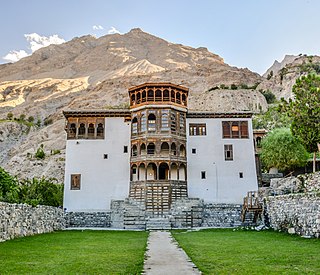
Khaplu, also spelt Khapalu, is a town that serves as the administrative capital of the Ghanche District of Gilgit-Baltistan, in northern Pakistan. Lying 103 km (64 mi) east of the town of Skardu, it was the second-largest kingdom in old Baltistan of the Yabgo dynasty. It guarded the trade route to Ladakh along the Shyok River east of its confluence with the Indus.

Gilgit-Baltistan, formerly known as the Northern Areas, is a region administered by Pakistan as an administrative territory, and constituting the northern portion of the larger Kashmir region which has been the subject of a dispute between India and Pakistan since 1947, and between India and China from somewhat later. It is the northernmost territory administered by Pakistan. It borders Azad Kashmir to the south, the province of Khyber Pakhtunkhwa to the west, the Wakhan Corridor of Afghanistan to the north, the Xinjiang region of China, to the east and northeast, and the Indian-administered union territories Jammu and Kashmir and Ladakh to the southeast.

Tourism in Gilgit-Baltistan, an administrative unit of Pakistan, focuses on the mountains. Gilgit-Baltistan borders Pakistan's Khyber Pakhtunkhwa Province to the west, a small portion of the Wakhan Corridor of Afghanistan to the north, Xinjiang, China to the northeast, the Indian-administered Jammu and Kashmir and Ladakh to the southeast, and the Pakistani-administered state of Azad Kashmir to the south.



